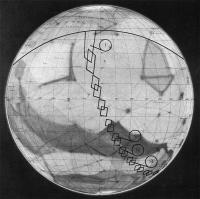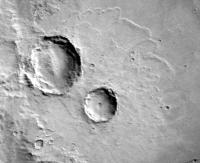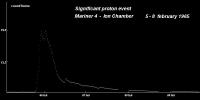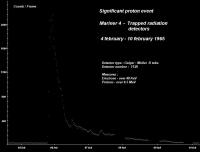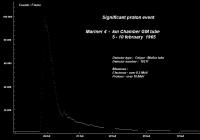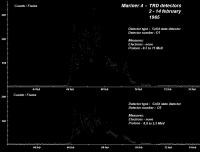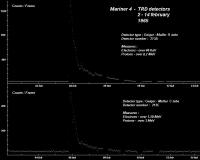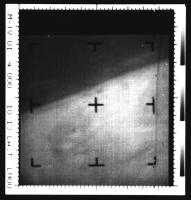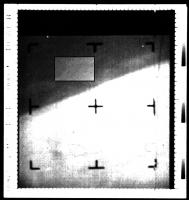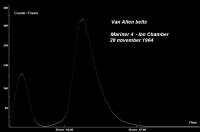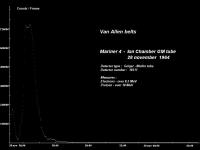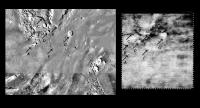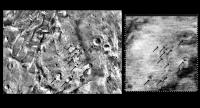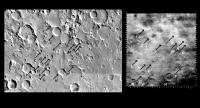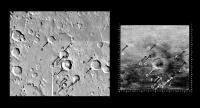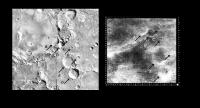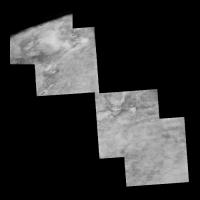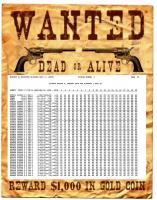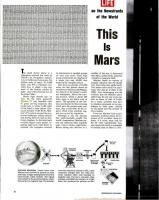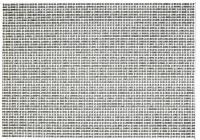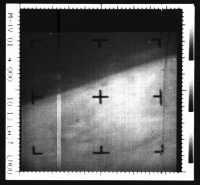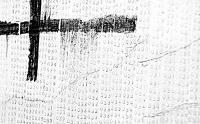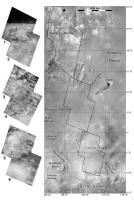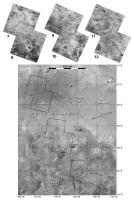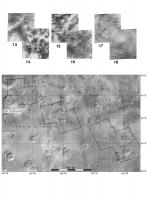Printable Version of Topic
Click here to view this topic in its original format
Unmanned Spaceflight.com _ Past and Future _ Mariner Mars 1964
Posted by: Phil Stooke Apr 28 2005, 05:05 PM
I am currently working on a book about lunar exploration, but looking ahead to the next one, which will cover Mars. One question to which I think I have an answer - but I'd like to see what my fellow Mars enthusiasts think - is this:
Mariner 3 failed to leave Earth. But if it had flown successfully, what area on Mars would it have photographed?
My understanding is that there was no specific plan. The MM64 press kit, for instance, says nothing about image coverage for either Mariner 3 or Mariner 4. I believe that navigation to planetary distances was still so uncertain that the flight team could not predict at launch the sub-spacecraft point at closest approach - uncertainties included the exact time of the flyby, the distance and the point at which the spacecraft would pass through the target plane. These things would be known closer to the flyby but they weren't precisely predictable at launch, so Mariner 3 never got to the stage of having an imaging plan.
Am I right?
Phil
Posted by: BruceMoomaw Apr 28 2005, 10:52 PM
Well, actually it DID leave Earth -- it just left Earth still wadded up inside its nose cone (and missed Mars by several tens of millions of km as a result of the added mass...)
I can confirm -- having followed the US space program pretty closely since the end of 1964 (in fact it was the 1964 Mariners that turned me into a fanatic on the subject) that there was no specific target planned for either of the 1964 Mariners. The 1969 Mariners were the first to have such a goal.
I imagine they would indeed have played it by ear for the 1964 Mariners, taking into account both the initial trajectory onto which the Mariners were injected by their Atlases and the serious needs of the non-imaging experiments (atmospheric occultation, flight through Mars' solar wind shock). I also know that any flyby distance between 3600 and 8600 miles was considered acceptable for the Mariners -- Mariner 4 was eventually targeted for a flyby at 5400 miles range, but due to a slight midcourse error actually flew at 6100 miles. As you say, their targeting accuracy at that time was not high enough that they could afford to get seriously persnickety over which part of Mars they tried to photograph with the two Mariners. It's likely that they would simply have assumed that, as long as the two Mariners photographed different parts of Mars, ANY two such different parts were acceptable. (I have, by the way, never been able to discover where the remaining 1969 Mars Mariner would have been retargeted had one of them failed early on.)
Personally, if Mariner 1 had succeeded, I wonder whether one of the 1962 Venus Mariners might have tried a radio occultation of Venus' atmosphere -- although Arvydas Kliore seems to have started pushing that experiment only in early 1964. I do know that this was actually the single highest-ranked experiment on Mariner 5.
And while we're taking a stroll through Space Memory Lane, remember that until Mariner 2 succeeded NASA was planning two more Mariner R spacecraft to be launched on Venus flybys in March 1964 -- with some science instrument modifications (improved microwave radiometer and magnetometer; ion chamber and cosmic dust detector replaced by the same UV photometer that got kicked off the 1964 Mars Mariners because it caused TV camera arcing, and finally DID get flown to Venus on Mariner 5. See "JPL Space Programs Summary #37-19".) I wonder if, had they been flown, THOSE Mariners would have carried out a radio occultation of Venus -- they even had high-gain antennas designed from the start to be smoothly tiltable, whereas Mariner 5's fixed high-gain dish had to add a feature allowing it to suddenly be tilted into a new fixed position to partially compensate for Venus' atmospheric refraction of its radio beam. (Since the 1964 Mariners had Earth sensors mounted on their high-gain dishes to aim and tilt them, they might even have been able to pull off another experiment very seriously considered but finally rejected for Mariner 5: an Earth sensor to measure the altitude of Venus' cloud tops.)
Coming soon, if you're all nice to me: a brief report on how NASA came within one month of trying to launch a VENUS ORBITER in June 1959 (although it definitely would have failed had it been launched). One of the most bizarre forgotten episodes of the early Space Age.
Posted by: JRehling Apr 28 2005, 11:13 PM
Mariner 3 failed to leave Earth. But if it had flown successfully, what area on Mars would it have photographed?
My understanding is that there was no specific plan. The MM64 press kit, for instance, says nothing about image coverage for either Mariner 3 or Mariner 4. I believe that navigation to planetary distances was still so uncertain that the flight team could not predict at launch the sub-spacecraft point at closest approach - uncertainties included the exact time of the flyby
[...]
If the time of the flyby was not well-constrained, then the answer falls out of that. An arrival a few hours earlier or later would have rotated any target terrain out of view.
It's an interesting question, however, since telescopic maps of Mars did exist, and there would therefore have been a basis for prioritizing targets, if the operational precision were there.
As a side note, we're now in a very similar circumstance with Pluto. Our telescopic (incl. occultation) maps of Pluto have roughly the detail that pre-Mariner maps of Mars did, and the single flyby we'll get will only provide best resolution at one longitude. (Although NH will certainly image the rest of Pluto in a way that Mariner 3/4 could not for Mars. Of course, Pluto won't receive any followups anytime soon.) It would be interesting to ask Alan Stern if any plutonian targets have thereby been prioritized. Have 40 years and a dozen+ solid worlds flown by given us any insights for Pluto-2006-launch that we lacked for 1964-Mars-launch??? The comparison is flawed, however: I think geometry regarding Charon's orbital position will actually drive the decision, rather than the visibility of specific Pluto terrain.
Posted by: Phil Stooke Apr 29 2005, 12:31 AM
Thanks for these comments. And Bruce, I was inadvertently thinking of Mariner 8 not leaving Earth. You were right, of course.
Phil
Posted by: edstrick Apr 29 2005, 09:35 AM
Mariner 4 had a scan platform, and one option they had was to do the flyby with the platform in a slow back-and-forth <I think> scanning mode, maybe within a limited angular range. The pre-encounter decision was, as I recall, to set the platform at an angle that gave a "best" single swath of pictures across the planet: Middle of the illuminated limb, approximately across the sub-spacecraft point, and on to the terminator.
Arrival date would have set the hemisphere covered. If Mariner 3 had not been enshrouded at launch, Mariner 4 would have launched earlier and imaged some other strip, possibly hitting more interesting features, possibly somewhat less.
Posted by: Bob Shaw Apr 29 2005, 12:05 PM
Bruce:
"Tell us about it, Janet!"
A 1959 Venus Orbiter - betcha it wasanother NOTSNIK!
Posted by: peter59 Apr 29 2005, 07:22 PM
Arrival date would have set the hemisphere covered. If Mariner 3 had not been enshrouded at launch, Mariner 4 would have launched earlier and imaged some other strip, possibly hitting more interesting features, possibly somewhat less.
You are right about Mariner 4 scan platform. A few hours before planetary encounter "NRT" (nonreal-time) power is turned on to energize the TV and scan platforms. The scan subsystem initiates a "search mode" of operation, causing the scan platform to oscillate such that the TV and scan sweep an arc approximately perpendicular to the motion of the spacecraft. When the planet comes in view of the scan subsystem sensor, the scan subsystem switches to a "tracking mode" in which the sensor and the platform is kept pointing at the planet.

More about Mariner 4 original telemetry data at http://www.petermasek.info
Posted by: BruceMoomaw Apr 29 2005, 11:48 PM
Yep. In fact, they decided some months before the flyby to orient the scan platform in advance such that it would already be aimed at the estimated center of Mars' disk as soon as the tracking system was turned on, thus eliminating any need to actually move the platform. (This, I think, is what is Ed Strick was really referring to when he mentioned a decision not to "do the flyby with the platform in a slow back-and-forth mode" -- that wouldn't have occurred during the actual photography session in any case.)
Now, the two 1969 Mariners had not only a 2-axis tiltable scan platform, but a Mars wide-angle sensor capable of keeping that platform pointed at the exact center of Mars' disk on both axes (not on just one axis and at just one time, like Mariner 4's wide-angle Mars sensor). This was to ensure good long-distance photos of Mars' whole disk by the narrow-angle camera during the few days before the flyby.
Posted by: edstrick Apr 30 2005, 08:36 AM
Bruce.. that matches what I recall without digging into the archives. I expect the design was intended to be able to find the planet, even if command capability had been lost and the flyby geometry was poorly known.
I'm still at a loss to understand why missions like Galileo and Cassini don't have "planet sensors" to help with fine targeting during close encounters. Cassini's lost full disk mosaics of moons just cause the targeting was say 50 or 100 km off and a big chunk of limb was clipped.
Mariner 69 was the "bridge" to everything later. Mariner 62 and 64 had "central computers and sequencers", but they weren't reprogrammable in flight. Mariner 69 had 128 or 256 command-words of storage. (Mariner 9 in 1971 had (I think) 512.)
With that added command capability, they were able to reprogram Mariner 7 to take a full tape recorder load of some 33 pictures instead of about 24 that Mariner 6 did, DESPITE having a Loss-of-Signal event and major spacecraft emergency only 5 days before, while Mariner 6 was doing it's close flyby. (They added more frames to the pass over the south polar cap and then let the tape run till it was full as it crossed the terminator over Hellas, trusting that real-time telemetry would get the nightside and night-limb data, as it had worked on Mariner 6.) Mariner 7's battery had overcharged, shorted, and *RUPTURED*, venting into the spacecraft, sending it into a roll, and giving a small propulsive nudge to the spacecraft from the vapors venting from the main body of the spacecraft!
Posted by: BruceMoomaw Apr 30 2005, 01:35 PM
Yep, that's all correct. (Don't ask me how I remember exactly how many command words in memory Mariner Mars '71 had, when I have no idea how many any later spacecraft had...)
While the '69 Mariners were indeed a complete quantum leap upwards from the earlier Agena-launched Mariners in many ways, though, I think the most dramatic was the incredible leap in their communications rate from 8 bps for the earlier Mariners to fully 16,200 bits for the '69 Mariners. I couldn't believe that figure when I first read it in 1968 and thought it was a misprint -- especially since the earlier design for the "Mariner B" line of spacecraft on which Mariner 69 was patterened only had a bit rate of (I think) 256 bps. However, there had been very dramatic improvements in communcations technology since Mariner B was designed in 1962, and NASA decided to take full advantage of them.
Mariner 7's recovery from near-disaster was indeed very lucky -- although not as lucky as the incredible Perils of Pauline experiences of Mariner 10, when they practically had pieces fall off the spacecraft all the way to Mercury. (I suspect it was that experience that soured NASA on cost-control programs for some time.)
Posted by: tedstryk Apr 30 2005, 02:27 PM
A planet sensor might be more trouble than it is worth in a system like the Saturnian system. For example, when studying one of the smaller moons, it might accidentally point the camera at Saturn, or even another moon. Also, it was originally hoped that the Mariner 4 track would touch the south polar cap, but it ended up missing. The planet sensor basically made sure that what happened to DS-1 at Braille did not happen (does anyone else find it ironic that imaging was unsuccessful at Braille?).
Posted by: Phil Stooke Apr 30 2005, 03:52 PM
Ted - thanks for this... I'm not doubting you, but I would really like a source for the statement about the intention to image the south polar cap. I would be looking for more details about the plan, sufficient to plot the intended image coverage as well as the actual coverage, on a map.
Phil Stooke
Posted by: tedstryk Apr 30 2005, 06:17 PM
I've got some documentation of this somewhere around here....might take a few days though....I need to figure out which box it is in, thanks to my recent move.
Posted by: edstrick May 1 2005, 07:59 AM
Mariner 69 and it's mission was designed around a much slower communications link than they ended up using. ... some 512 bits/sec compared with 8 <at mars> for Mariner 4. The 16,200 bps data rate was an "engineering test" included on teh spacecraft. The original goal was to tape some 8 late far encounter full disk images and fill the rest of the tape with near encounter images.
Since the high-data-rate link worked flawlessly and clearly had plenty of margin at Mars, the mission ended up using it for all it was worth.
Similarly, Mariner Venus/Mercury 1973 <Mariner 10> was designed around a 16,200 or whatever datarate, and included an engineering-test data rate of 144,000 or some such data rate with the intent of using it for real time transmission of all data if it worked and taping the closest encounter frames on a Mariner 9 vintage tape for backup and multiple replay to get best quality data.
Posted by: edstrick May 1 2005, 08:01 AM
Ted... I'd assume a planet sensor would only be "enabled" for final targeting adjustments when the target was already in view. Basically an auto-nav capability. They *** SHOULD *** have been able to do it using data from Cassini's wide angle <relatively> camera, but maybe the antique computer on Cassini can't do that much math. <sarcasm here>
And yeah... I though Braille was a bad-luck name choice even before DS-1 flew past.
Posted by: gndonald Aug 9 2005, 02:04 PM
I'm also intrigued about this and the current status of the http://www.petermasek.info/mariner4.html page mentioned above.
Posted by: The Messenger Aug 11 2005, 10:22 PM
In 1964, the question of whether there were 'canal' on Mars was still open, and although the Mariner 4 photos produced no evidence of canal, there was enough graininess to leave the question open - at least for the 'Hoaglandites'.
With both Mariner 3 and 4, they were hoping to get as close as possible, within NASA planet contamination control constraints, which was about 6000km.
http://ntrs.nasa.gov/archive/nasa/casi.ntrs.nasa.gov/19680009274_1968009274.pdf
Posted by: PhilCo126 Oct 27 2005, 04:49 PM
Phil Stooke ... when will You start the work on the Mars exploration book ?
An interesting source for writing books & articles are the NASA Technical Reports written for each mission... I have made a list of the most important Tech Reports at the weblink below ( with thanks to Donald Boggs for hosting the list on his excellent spaceflight books website ) ![]()
http://www.boggsspace.com/jpl_tech_reports.htm
Best regards,
Philip
![]()
Posted by: Phil Stooke Oct 27 2005, 04:50 PM
I'm in the editing phase on the Moon book. Next year at this time I hope to begin the Mars book.
Phil
Posted by: PhilCo126 Oct 27 2005, 05:18 PM
Great Phil ... don't hesitate to contact me whenever You need some information ![]()
By The Way are You also on forum collectSpace.com ?
Best regards,
Philip
![]()
Posted by: Tom Tamlyn Oct 29 2005, 02:22 AM
In Bruce Murray's book "Journey into Space: The First Three Decades of Space Exploration" (1989), Murray gives an account of of a coup he pulled off for one of the early planetary spacecraft, which might be relevant to the quantum leap to which Bruce refers.
In the process of designing a mission, Murray was frustrated by the bandwidth limitations of communications with the Deep Space Network. Despite what Murray described as a policy of DSN to reveal as little information as possible to other NASA centers, an unguarded remark in a paper by a DSN engineer gave Murray an inkling that DSN's actual communications abilities were substantially (orders of magnitude?) better than it was willing to admit.
Murray made them 'fess up, and the mission's product return goals were substantially increased.
***
My memory tells me that this anecdote related to a sixties mission and that the destination was Mercury, but one of these must be false, since Mariner 10 wasn't launched until 1973. I owned the book briefly when it came out, thanks to an enthusiastic review in the NYT, despite the fact that my interest in space exploration was in a decades-long lull that didn't pass until December 2003. I had expected an armchair tour of Pioneer, Voyager, etc., and was disappointed by Murray's focused recollections of small group interactions and institutional politics. I had to borrow another copy from the library to reread it last spring, when I found it much more interesting. The account of early Shuttle politics is grimly fascinating.
Murray also singles out for criticism one or more eighties NASA administrators who couldn't be bothered to show up for important unmanned spacecraft rendezvous. The more recent administrators are doing much better.
Tom Tamlyn
Posted by: PhilCo126 Nov 28 2005, 05:54 PM
Phil ... with ' information ' I meant in fact 'documentation' as I have a large collection of NASA photos showing unmanned spacecraft being tested & assembled before launch... So if You need a High Res photo, don't hesitate to contact me!
Philip
http://mars-literature.skynetblogs.be/
![]()
Posted by: tasp Nov 29 2005, 03:32 AM
The only information I could find in my library was a reference to Atlas Able 4. Launch date seems to have been 11/26/1959 and the launch was a failure. Payload was a TV camera to view the earth's moon from lunar orbit. Original destination was Venus. Weight was under 400 lbs.
What's "the rest of the story"?
Inquiring minds want to know!
Should we fawn or something?
Posted by: mcaplinger Nov 29 2005, 05:40 AM
Murray made them 'fess up, and the mission's product return goals were substantially increased.
Not quite. The mission was Mariner Venus-Mercury 1973 (aka Mariner 10) but the realization was that if the bit error rate was increased the bit rate could also be increased, and with imaging it didn't matter much if the bit error rate was higher, since isolated bad pixels could be removed with simple filtering techniques (such as median filters.) MVM73's bit rate was 117 Kbps at a BER of 5e-3 for this reason.
See http://history.nasa.gov/SP-424/app-b.htm for more info.
Posted by: BruceMoomaw Nov 29 2005, 05:56 AM
Fawning won't be necessary. It was indeed the originally planned destination of one of the 1959 Atlas-Able probes. It and the probe that later became Pioneer 5, after being launched in 1960, were to be launched in the direction of Venus in the first few days of June 1959 -- but Pioneer 5 (lauched by a Thor-Able, later to be renamed Thor-Delta) had no midcourse correction system and so would certainly have missed Venus by a great distance, whereas the spin-stabilized Atlas-Able probe had two hydrazine engines pointing out its two poles. The rearward pointing one could be fired four times; the forward-pointing one only twice (at least in the lunar version), with one of those burns being for final orbit insertion -- but apparently they had some confidence that this awkward setup could put them close enough to have a shot at orbiting Venus.
This thing came astonishingly close to being launched -- the front-page headline for the NY Times on (I believe) May 1, 1959 shows the mission being cancelled only then, apparently because the planned science experiments couldn't be gotten ready in time. I've spent years trying to find out what those experiments were, but the only clue I've found is a single paragraph in a 1959 issue of "Astronautics" magazine quoting a Lousisiana Congressman on "Meet the Press" who very briefly described them in a way which implies that they were exactly the same as on the second Atlas-Able Pioneer, which was scheduled for a launch to the Moon later in 1959. That is, they were particles and fields experiments, plus an IR photometer that could build up a low-resolution spin-scan map -- of the Moon's farside, or (presumably) Venus' cloud tops. (I'd assume that such a craft could have carried a UV photometer like Mariner 5's, to measure the planet's atomic H and O and thus provide an indirect estimate of its water vapor; but this wasn't mentioned. I also presume that it could, in any case, have carrried out radio occultations of Venus' atmosphere.)
At any rate, after that cancellation, Pioneer 5 was rescheduled for a launch in late 1959 into a solar orbit with its perihelion at Venus' orbit -- and after months of technical delays it ws finally launched in March 1960, although the booster underperformed somewhat and so it fell well short of reaching Venus' orbit. They had hoped to communicate with it at distances of up to 50 million miles, but a slow battery leak finally silenced it 22.5 million miles out -- which still utterly shattered Pioneer 4's radio-range record of 407,000 miles.
The Atlas-Able probe was rescheduled for that single launch to the Moon on Oct. 3 (a day before the Russians launched Luna 3), but its Atlas booster blew itself to kingdom come during a static test on Sept. 24, so they drafted the Atlas that had been scheduled for the second unmanned Mercury "Big Joe" test (which had been cancelled because the first was successful) and attached the Able upper stages and the probe to that instead. It took off on Nov. 26 and immediately failed ignominiously because its payload shroud hadn't been adequately vented and came off due to internal air pressure about 45 seconds after launch; the air blast quickly tore off the probe and the third stage, and damaged the second state enough to knock out its radio (apparently it then ignited without separating from the Atlas). This, of course, would have happened had it been launched to Venus.
Since the cancellation of the Venus launch meant that they still had a second such probe built, the White House ordered a third probe to be built, one launch attempt to be made in 1960, and the third probe launched only if that first 1960 effort failed. Alas, they too both failed. (Neither carried that IR scanner; instead, they were the very first US spacecraft to carry plasma analyzers.)
Clearly NASA's very early ambitions exceeded its grasp; the agency must have initiated this plan almost as soon as it was created at the start of 1959. It's very hard to find data on the Venus plan for this thing, but I first heard about it at age 11 from the space column of a 1959 back issue of "Sky & Telescope". You can find sprinkled references to it in other places, such as Aviation Week -- and notably that NY Times front-page headline article -- but about a decade ago, when I corresponded with one of the experimenters for the Atlas-Able probes' radiation experiments to try and get more information on it (he'd written a late 1980s nostalgic retrospective in a major science journal), I was thunderstruck to learn that HE had never heard of the Venus part of the plan!
Posted by: BruceMoomaw Nov 29 2005, 06:05 AM
You can find a brief Web reference to it: a chapter of Homer Newell's official 1979 NASA history document "Beyond the Atmosphere: The Early Years of Space Science: http://www.hq.nasa.gov/office/pao/History/SP-4211/ch10-4.htm . (There were nine early Pioneers rather than eight, though -- he forgets the Air Force's very first lunar Pioneer attempt in August 1958.)
Posted by: tasp Nov 29 2005, 06:19 AM
Amazing!
NASA certainly had the 'vision thing' right out of the starting gate. I suppose with no past negative experiences in trying an ambitious planetary mission, everyone involved was pretty gung-ho to orbit Venus.
Egad, what if they had tried and succeeded?
Appreciate the update on this, I had never expected to know any more than what I posted about Atlas Able 4. Jane's had put out a reference book in 1987 that had a brief blurb on the mission. They did have a launch photo of Atlas Able 5, too.
Wonder what else they were thinking about back then?
Posted by: edstrick Nov 29 2005, 07:59 AM
Random note: The UV photometer that flew on Mariner 5 to Venus was supposed to fly on Mariner Mars 64, but the instrument had high voltage electrical problems during development, and was replaced by a mass model (and maybe electrical-draw model, to preserve fidelity to all spacecraft/instrument interactions) that of couse did nothing scientifically. The problems were fixed in time for Mariner Venus 67.
Posted by: BruceMoomaw Nov 29 2005, 08:00 AM
Try the combination of "Venus" and "Atlas-Able" on Google. I did just now and found a few new tidbits -- including one article ( http://66.102.7.104/search?q=cache:Lt4FgV9CzekJ:leitl.org/tt/msg02219.html+venus+%22atlas-able%22+arpa&hl=en ) that goes into a bit more detail about just how NASA initially embraced this thing (apparently it started out as the Air Force's planned successor to its unsuccessful 1958 Pioneer lunar orbiters), and one German author ( http://www.bernd-leitenberger.de/pioneer-p.html ) who's dug up the precise cause of that static-firing Atlas explosion.
However, LePage's article says that NASA decided to cancel the Venus orbiter (though not the Pioneer 5 Venus flyby) very early in 1959, which directly clashes with that NY Times article and my other sources. And the German's got the failure causes of the remaining three flights mixed up -- his very last paragraph records the true cause of the Nov. 1959 failure while mixing it up with the Dec. 1960 failure, and he falsely says that the Nov. 1959 failure had a similar cause to the Sept. 1960 one, having clearly instead printed two accounts of the latter that differ slightly in their phrasing.
Posted by: BruceMoomaw Nov 29 2005, 08:07 AM
Yeah, I've got the full dibs on the process by which Mariner 5's science payload was selected. And I knew about the 1964 problems with the Mariner Mars UV photometer all the way back in 1964, nyahh nyahh! (It was only some time later that they decided to add the radio occultation experiment, which as things turned out told us a lot more about Mars.)
The problem with Mariner 5 is that they decided to fly it literally at the last minute -- Dec. 1965 -- and there was simply no time to develop some of the experiments they would have liked most to include, such as UV or IR spectrometers. (In fact, the radio occultation experiment was officially ranked as the most important one!) But they did come fairly close to adding an Earth-occultation photometer that could have told us what the cloud-top altitude was, which makes me wonder whether it might have clued us in to the clouds being sulfuric acid -- which instead wasn't discovered until 1973.
By the way, I first learned about the cancelled 1959 Venus orbiter back in 1965. The Space History Geek Knows All! (Or would like to think so.)
Posted by: BruceMoomaw Nov 29 2005, 08:19 AM
While we're on the subject of lost opportunities: I heard in spring 1967 that NASA was seriously considering launching a sixth Lunar Orbiter made out of the program's leftover spare parts (though it was thought unlikely even then), and remember thinking how nice it would be if they'd fly it with a copy of the gamma-ray spectrometer from the failed 1962 Rangers. In 1977 I learned, to my astonishment, that they had planned to do just that. (Otherwise it would have been similar to Orbiter 5, but would have photographed the Moon's far side in as good detail as Orbiter 4 had done for the near side.)
Well, they ended up leaning against flying this (it would have flown in Nov. 1967) even if Orbiter 5 had failed, and its success totally kiboshed Orbiter 6. I find myself wondering, though, just how much of Lunar Prospector's data might have been gotten three decades earlier if they had flown this -- or put the GRS on Orbiter 5. (I doubt the GRS could have detected the hydrogen at the poles, but I don't know it for sure.)
Posted by: edstrick Nov 29 2005, 08:33 AM
Bruce Moomaw: ".... But they did come fairly close to adding an Earth-occultation photometer that could have told us what the cloud-top altitude was, which makes me wonder whether it might have clued us in to the clouds being sulfuric acid -- which instead wasn't discovered until 1973....."
I doubt it would have helped much. We actually "knew" what the cloud top altitude was from the visible/(and IR?) spectra of CO2, assuming the atmosphere was CO2 dominated, and not mostly nitrogen. And UV data indicated little Rayleigh scattering gas above the cloudtops, so there wasn't a huge over-abundance of Nitrogen.
What we didn't know was the "altitude" o fhte suface below the cloud tops!.... where the bottom was.
The expectation was that we'd eventually learn the cloud composition from infrared spectra, but that was "underinformative" and we weren't experienced enough to find a match to the so-so at best quality data we had. Somehow, people never included sulfuric acid in lists of candidates matched against cloud data so there never was a good match. A review article from the early 70's showed a distinct sense of frustration at the lack of progress and lack of signs of how to make progress in solving the problem.
It took polarimetery data from earthbased observations to suddenly break the logjam. It showed with astonishing precision that the cloud particles were non-absorbing spherical droplets, about 2 micrometers in size with a narrow size distribution, and last but overwhelmingly most importantly ... a refractive index of 1.44 +- 0.01 (If I remember right).
This totally blew away any candidates and yielded 90% sulfuric acid droplets as the only even close match.. and it wasn't close.. suddenly everything fit and made sense.
Posted by: BruceMoomaw Nov 29 2005, 09:08 AM
They certainly came breathtakingly close before then -- hydrochloric acid was one of the favorite theories.
Posted by: edstrick Nov 29 2005, 10:31 AM
I'd have to dig in my "stacks" to find the review article that tried to evaluate a good number of candidates for Venus' Clouds against the observational data and failed. Hydrochloric was one of them, and flunked on a number of grounds, I think the main one being the observed abundance above the clouds was far to low for the clouds observed temperature. They'd have to have been much colder to have the observed HCL vapor levels.
Sulfuric Acid just didn't seem to be on anybody's list so the multiple choice answere was: D.) None of the above. It might have emerged as a leading candidate if it had been included in the list.
Based on Venera and Vega descent composition data, and argued-about Pioneer Venus cloud particle spectrometer results, there are other composition particles in the clouds, but we know almost nothing about them, and the information is distinctly contradictory. Venera 13/14 and/or Vega 1/2 collected aerosol on a filter and then x-ray fluorescence'd them for element abundances, and got (besides sulfur), I think, Iron and Phosphourus. Iron Chloride was a proposed cloud component in the early 70's, I think. Sulfur crystals are one candidate for larger particles, but I don't know the current status on that as a candidate.
Polarimetry has almost always been a technique in search of problems to solve in Planetary Science. Unfortunately, it's far less revealing of particle properties when measuring scattered light from solid, non-spherical particles, whether they're martian dust and ice hazes, Jovian etc ammonia and other hazes, or Titanian tholin smog. It does help study atmosphere structure, the size/abundance of aerosols with altitude, and the crude physical properties of the aerosol particles, but it's only had the one "mega-success" of nailing the main Venus cloud composition.
Posted by: ljk4-1 Mar 15 2006, 03:21 PM
Any truth that Mariner 4's flight path was aimed at a region of the
planet where a number of "known" canals were?
Posted by: Phil Stooke Mar 15 2006, 04:24 PM
Not really. Any long strip of images like that would cross a few canals. The targeting was all just about the trajectory design and a desire to see light and dark areas.
Phil
Posted by: BruceMoomaw Mar 15 2006, 10:38 PM
At that time they had very little confidence in their ability to aim the Mars Mariners within more than a few thousand km of ANY target -- and sure enough, Mariner 4 ended up flying by Mars at 1200 km higher altitude than had been intended in the midcourse maneuver. Just photographing Mars would be adequate.
Posted by: edstrick Mar 16 2006, 07:53 AM
For the canal freaks, the flyby trajectory and viewing was rather disappointing, as the image strip generally crossed what were generally mapped as minor, low-contrast canals.
What finally nuked the canalist's hopes were the global Mars Rotation Sequences from Mariners 6 and 7 on approach.
Posted by: Bob Shaw Mar 16 2006, 04:25 PM
What finally nuked the canalist's hopes were the global Mars Rotation Sequences from Mariners 6 and 7 on approach.
Imagine if the random-ish targetting of Mariner IV had picked up on any of the dried up river channels - or if we'd recognised what we were seeing on those Mariner 1969 far encounter sequences (Valles Marineris is there, if you look not very hard at all!). Or if just *one* Soviet image had scooped the US with a picture of a dried-up-something, or a volcano, or...
Still, we got there in the end (and even Mars Observer has now, in effect, flown again!).
Bob Shaw
Posted by: BruceMoomaw Mar 16 2006, 10:41 PM
Oh, yes. I well remember the shock when the dust cleared and all those things started getting gradually unveiled before Mariner 9. Still, I doubt that their earlier discovery would have done much to change the schedule of launches -- the one aspect of that schedule that wasn't rational was the launch of the 1969 flyby Mariners instead of jumping directly to 1971-type orbiters, and that was a consequence of the fact that the Mariner Mars program kept getting expanded incrementally as the Voyager Mars program gradually fell apart. (I even learned recently that in 1968 they seriously considered cancelling the second 1969 Mariner flyby so that they could save money by rebuilding the craft into one of the 1971 Mariner orbiters, as they rebuilt the 1969 spare flyby craft into the other 1971 orbiter.)
Posted by: PhilCo126 Mar 17 2006, 06:13 PM
Talking about Mariner IX... Phil (Stooke) I've contacted You about the Martian Moons article ![]()
Thanks again for Your help...
Philip
![]()
Posted by: Bob Shaw Mar 17 2006, 11:28 PM
Bruce:
As things turned out, yes - but if Mars had been seen as more like Earth than merely a big Moon then we might have seen quite a different turn of events. Stephen Baxter had fun with some of these possibilities in his novel 'Voyage'.
Bob Shaw
Posted by: Michael Capobianco Mar 17 2006, 11:45 PM
As things turned out, yes - but if Mars had been seen as more like Earth than merely a big Moon then we might have seen quite a different turn of events. Stephen Baxter had fun with some of these possibilities in his novel 'Voyage'.
Bob Shaw
I wrote a story with William Barton that appeared in Amazing a few years back called "Thematic Torus in Search of a Cusp." It's also alternate history starting with Mariner IV finding large structures on Mars. For us as kids Mariner IV was a watershed event, and I didn't really get interested in planetary exploration again until Voyager.
Michael
Posted by: BruceMoomaw Mar 18 2006, 12:19 AM
It was for me, too. Although I was already interested in science, it was the news in a Sept. 1964 issue of "My Weekly Reader" that there were two Mariners scheduled to go to Mars (which I hadn't known, although I already knew about the Rangers and the 1962 Mariners) that turned my tentative interest in Solar System exploration into a flat-out obsession.
By the way, Harry Turtledove -- who specializes in alternate history (he's just finishing up Vol. 10 of his grisly history of the world if the South had won the Civil War) -- wrote a novel called "A World of Difference" back around 1990 on how things would have turned out if everything had been just as it actually is except that Mars was Earth-sized and therefore capable of holding a CO2 atmosphere dense enough to keep it habitable despite its distance from the Sun, and the last photo from Viking 1 had shown an indignant native advancing on it with a club. Plausibly but depressingly, the US and the Soviets would immediately have started trying to convert the Martians to their particular ideologies. (Since such a planet would have been dazzlingly bright white rather than red, it would have been called "Minerva".)
P.S.: I admire the hell out of Barton's considerably grimmer and more likely alternate history story "Age of Aquarius", on what the Sixties would have been like if the Cuban Missile Crisis had turned out just a wee bit differently.
Posted by: Michael Capobianco Mar 18 2006, 01:09 AM
I do too, and I'm a character in it.
Michael
Posted by: ljk4-1 Mar 20 2006, 04:16 PM
'Now that we have a map, let's start colonizing outer space'
The Register Mar. 17, 2006
*************************
Mapping the solar system started in
1965 when Mariner 4 sent back much
improved pictures of Mars, said SETI
expert Seth Shostak. Since that
time, astronomers -- with the help
of high-powered telescopes and
various exploration vehicles and
probes -- have delivered stunning
pictures of most of the planets and
their moons. The quality of these...
http://www.kurzweilai.net/email/newsRedirect.html?newsID=5393&m=7610
Posted by: DonPMitchell May 31 2006, 03:48 AM
Hey, I'm interested! Was this the idea of sending Pioneer 5 toward Venus?
One of the greatest old books on space is the McGraw Hill Encyclopedia of Space (1968). Find a copy if you can, and buy it! I sure wish someone would put together a contemporary book that's as good. One odd thing about this book is that it lists Pioneer 5 as a failed Venus probe, which I don't think is quite accurate. But the idea must have still been in the air then.
And I'm still looking for a really good photograph of Pioneer 5.
Posted by: BruceMoomaw May 31 2006, 06:18 AM
The scheme was more complex than that. It did involve launching Pioneer 5 toward Venus in early June 1959, but without a midcourse correction motor no one thought it would get anywhere close. HOWEVER: it also involved simultaneously launching the very first of the much bigger Atlas-Able Pioneer orbiters to Venus -- and since that had two restartable hydrazine motors sticking out of its poles, the plan really would been to make an honest effort to put it into Venus orbit. Aviation Week had several short items on it in 1959 -- and the NY Times of (I believe) May 1, 1959 made the plan's last-minute cancellation its front-page headline. (It was cancelled on the grounds that "the science payload could not be gotten ready in time", by which NASA may have meant the entire spacecraft.)
A second Pioneer orbiter was to be built simultaneously to be put into lunar orbit later. I've wasted a little time trying to find out what the exact science payload of the Venus version would have been, and all I've been able to find is one short paragraph in a 1959 aerospace magazine quoting a Democratic Louisiana Congressman briefly describing its payload on "Meet the Press" in a way that suggests it would have been identical to the payload on the lunar Atlas-Able orbiter -- that is, a bunch of fields and particles instruments plus a spin-scan IR photometer that could build up images (in this case, presumably a temperature map of Venus' cloud cover). No mention of a UV photometer, which would seem to be a natural for such a mission -- but such an orbiter could have given us radio occultations of the atmosphere.
I first heard about this plan all the way back in 1965, when I was 11 years old. (It was mentioned briefly in a back issue of "Sky and Telescope".) But finding information on it is like looking for an Upsidaisium mine -- you just find tiny crumbs here and there (including one brief mention in the June 1959 "American Mercury", H.L. Mencken's magazine which by then had been bought by a bunch of rabid right-wing anti-Semites who used to refer to "the Jewish termites gnawing at the Cross"). I finally found, in an early 1990s issue of the Proceedings of the National Academy of Sciences, a long historical reminiscence by a fields and particles scientist mentioning some of the instruments he'd put on these Atlas-Able orbiters, and I eagerly asked him for the Straight Dope -- only to be told that even HE had never heard of the Venus plan!
Anyway, after the cancellation of that plan, the goal of the smaller Pioneer 5 remained to be put into a solar orbit with its perihelion at Venus' orbit -- and after sitting on the pad through delay after delay during the last half of 1959, it finally got off the ground in March 1960 and became the only genuine success of the early Pioneers (although its perihelion ended up considerably outside Venus' orbit, and its power supply failed at a range of 22.5 million miles instead of the 50 million hoped for). The plan to launch a single Atlas-Able orbiter to the Moon remained; and after its planned October launch was scrubbed when the booster blew up during a September static test, NASA grabbed the Atlas planned for the cancelled second Mercury "Big Joe" test and launched it in late November -- only to end up with the infamous "turkey shoot" in which the shroud came off due to inadequate venting of internal air pressure, and the air blast then tore off the probe and third stage and crippled the second stage. No doubt this would have been its fate had it been launched to Venus in June.
Since this meant that there was still one spare Pioneer orbiter, Eisenhower gave permission to try to launch it to the Moon in late 1960 -- and to build a third copy for one last attempt if the second one failed. Unfortunately, both the second AND third tries also failed ignominously (due to failures of the second stage, which by then was usually working pretty reliably on Thor-Able). Both these versions had slightly changed science instruments -- the IR farside spin-scanner was removed and replaced by the first plasma probe on any NASA spacecraft, for instance. All the instruments on those two 1960 lunar orbiters were fields and particles; pretty much the only information they could have gotten on the Moon itself was to look for a magnetic field, but then that was also the case for Explorer 35. And so ended one of the stranger (and sadder) forgotten stories of the early Space Age.
Posted by: DonPMitchell May 31 2006, 06:33 AM
Very interesting. I don't think their rockets could have hit Venus at that time, and I'm pretty sure the telemetry system couldn't have picked up its signal (Only Jodrell Bank could get Pioneer 5's signal after about a month), so there were probably a lot of reasons it was not actually done. But it is too bad there is not more written about this.
Posted by: PhilHorzempa Jun 9 2006, 04:57 AM
I have been intrigued by the notion of comparing detailed images,
from the Viking Orbiters or Mars Express, of the same areas of Mars
photographed by Mariner 4.
Here is a view of the footprints of each Mariner 4 image.
Here is a link to a low-res map of where those images are located
on Mars.
http://www.solarviews.com/raw/mars/mar4geom.jpg
Does anyone have access to Viking or Mars Express images that
would match up with those of Mariner 4?
Another Phil
Posted by: ljk4-1 Jun 10 2006, 05:48 PM
Here are images of the famous Mariner Crater (Number 11) taken by
Viking 1 Orbiter and Mars Global Surveyor:
http://www.msss.com/mars_images/moc/3_18_99_mariner/
And someone please correct me if my memory is faulty, but I think that
this book showed Mariner 6-7 images overlapping Mariner 4 images:
Davies, Merton E., and Bruce Murray, The View from Space, Columbia University Press, New York, 1971
Posted by: Bob Shaw Jun 10 2006, 08:52 PM
The odd thing about that famous Mariner IV crater image is that in fact it *did* show something remarkable. At seven o'clock is to be found the pair of inset craters, and the Viking image reveals what Mariner IV was unable to see: lobate flow features associated with the impacts. Had these only been recognised as impacts into a volatile-rich surface then Mars exploration might have taken a different turn!
Bob Shaw
Posted by: tedstryk Jun 10 2006, 09:04 PM
It also photographed half of Orcas (Orcus?) Patera, but it was mistaken for another impact crater.
Posted by: Phil Stooke Jun 11 2006, 12:15 AM
Another Phil asked:
"Does anyone have access to Viking or Mars Express images that
would match up with those of Mariner 4?"
You might want to try Google Mars. These days we all have access! I've played around with that comparison, it's quite interesting especially for the earlier M4 images. In fact this will form part of my future Mars book.
And ljk4-1 said:
"And someone please correct me if my memory is faulty... "
Well, it probably is faulty! There was no overlap between Mariner 4 and Mariner 6/7 images. And those two authors would not have made a mistake like that. I don't have the book in front of me, but it wouldn't have shown that.
Ted mentioned Orcus Patera. Paterae are usually volcanic craters, but I think everybody believes now that Orcus is really just a giant oblique impact like Schiller on the Moon.
Phil
Posted by: Bob Shaw Jun 11 2006, 12:47 AM
Phil:
It'd have been quite a good idea to overlap the early Mariners imaging swathes, though in reality just hitting the planet with the cameras at all was a triumph!
I wonder what Mariner IV class images of other potential targets would have looked like? If water erosion features had found themselves below the cameras, would they have been visible?
Imagine if Mariner IV had found a river valley...
Bob Shaw
Posted by: edstrick Jun 11 2006, 09:45 AM
In Mariner 4's image #11 (THE crater), a fault graben radial to Tharsis is partly visible cutting across the rim of the large crater. I think it was noted during or after mission image analysis, but minimally commented on. It was visible as some sort of lineation, but what it really was needed more resolution and less noise.
Posted by: Phil Stooke Jun 11 2006, 11:53 AM
Bob, the Mariner 6 and 7 strips did intersect, in Meridiani. But I don't think it would have been useful to have M6 and M7 overlap M4 - better to sample other parts of the planet. M4 would have had no trouble resolving large channels like Ma'adim, or the mouths of Tiu and Ares.
Phil
Posted by: Bob Shaw Jun 11 2006, 01:18 PM
Phil
Phil:
And, somehow, they all managed to miss the most critical parts! It certainly demonstrates the utility of orbiters versus flyby craft.
Bob Shaw
Posted by: ljk4-1 Jun 11 2006, 02:47 PM
"And someone please correct me if my memory is faulty... "
Well, it probably is faulty! There was no overlap between Mariner 4 and Mariner 6/7 images. And those two authors would not have made a mistake like that. I don't have the book in front of me, but it wouldn't have shown that.
Ted mentioned Orcus Patera. Paterae are usually volcanic craters, but I think everybody believes now that Orcus is really just a giant oblique impact like Schiller on the Moon.
Phil
Hey, go easy on an old man's memory! I think what I was remembering now was
the Mariner 6 and 7 images overlapping each other.
Here is the Mariner 4 image of Orcus Patera. It caught the end of the feature.
Too bad the image was so poor that it was hard to make out any real details.
http://nssdc.gsfc.nasa.gov/imgcat/html/object_page/m04_03b.html
And here is a paper debating whether OP is an impact crater or a volcanic feature:
http://www.geology.pomona.edu/research/Faculty/Grosfils/Mars/Impact_Cratering/publications/Dolores_Krystal_Final_1085.pdf
Posted by: edstrick Jun 12 2006, 07:48 AM
Note that despite the overwhelming impression of historical press coverage and post 1970 "historical" space reporting, Mariner 6 and 7 did see some of the "best" pieces.
Mariner 6 got some relatively clear views of chaotic terrain with the narrow angle camera and clear context from wide angle data that showed the "thermokarst like" (I think they said) collapsed terrain was part of a much larger regional feature extending into the west toward the limb and high-sun-illumination part of the disc.
Mariner 7 showed some sub-parallel ridges and mountainous terrain on the edge of Hellas, and "featureless terrain" (apparently haze-filled atmosphere) on the floor of Hellas, leading the researchers to conclude (on the basis of imperfect evidence) that there were much younger terrains than the cratered terrain.
Mariner 7 showed a complex pitted, cratered, and eroded terrain within the south polar cap, including the first view of the polar layered terrains. They couldn't guess what they were but they were clearly features of great interest.
We didn't see the great channels or the great volcanoes, that was the bad luck of the camera pointings, but we DID get informative glimpses that there was much more than just old cratered terrains.
Posted by: BruceMoomaw Jun 12 2006, 08:54 AM
There was certainly little mention of this at the time.
Posted by: Bob Shaw Jun 12 2006, 10:21 AM
Yes, certainly chaotic terrain was a discovery, and the polar cap images were good too - but it remains the case that the show-stoppers were all missed. What's really frustrating is the way that so many features were almost visible during the far encounter - and then Mars turned it's face away. Olympus Mons, Valles Marineris and the rest are all just visible, but were not understood. Phil Stooke and I have both got old globes of Mars which were based on Mariner 6 & 7 data (and earlier) and on these Olympus Mons is depicted as a giant double crater (the outer aureole was interpreted as a crater wall). Mariner 6 & 7 certainly saw many interesting features, but it was Mariner 9 which breached the floodgates.
Bob Shaw
Posted by: tedstryk Jun 12 2006, 11:52 AM
I think a lot of the reason was that the Tharsis area had long been thought of as the "boring" area - not many pronounced features visiblie in a telescope. The southern hemisphere had much more intricate features.
Posted by: ljk4-1 Jun 12 2006, 12:18 PM
The famous August, 1970 issue of National Geographic Magazine discusses
Mars pre-Mariner 9. They make it very clear that - at least for the scientists
they interviewed - Mars was a dull place, mainly craters and some rough
terrain at best.
Amazingly different talk from just a few years earlier, when most of them
assumed Mars was enough like Earth to at least have simple life forms
(lichen and such). Even the infamous canals were thought to at least be
natural water channels.
http://www.aliensonearth.com/catalog/detail/0720/0720K304219.html#image
Here is an image of an old Mars globe with Mariner 6 and 7 photos pasted
across it:
http://beacon.jpl.nasa.gov/Histphotos/hpom/241-267.html
Posted by: Phil Stooke Jun 12 2006, 03:26 PM
Bruce said "There was certainly little mention of this at the time", but actually it was reported as early as the Mariner 6/7 Mission Report MR-6, dated 10/29/69, and in Science, vol. 166, 3 Oct. 1969, p. 62... chaotic terrain was well seen and described. The real problem was the high sun angle which made it harder to interpret. With hindsight small channels can be seen too (frame 6N16). But hindsight is the big help here. If you expect another moon that's what you see.
Phil
Posted by: peter59 Oct 22 2007, 03:57 PM
Little bit of history.
Mariner IV - voyage through Earth's magnetosphere.
For the first 16 2/3 hours of flight, the Mariner IV spacecraft was programmed to roll at a rate of about 1 revolution every 30 min. Since the magnetic field of the Earth was known, it was possible to correct the magnetometer data for any bias caused by the small remnant field of the spacecraft itself. The roll calibration insured that later data taken from the instrument in the very small field of interplanetary space could be assigned absolute values.
Source : Mariner 4 Master Data Records
Tape : K-0141
5400 frames extracted
Transmision rate - 33 1/3 bps
Time period: 28 november 15:20 - 29 november 10:10, year 1964
Averaging - 12,6 sec per pixel (4 measurements from 1 frame)
Z - axis top
X - axis middle
Y - axis bottom
Posted by: peter59 Nov 6 2007, 09:34 PM
Little bit of history.
Mariner IV - significant proton event February 5, 1965
The class 2 solar flare of February 5 started at 17:50 U.T., reached a maximum near 18:10 U.T., and ended near 20:00 U.T. An X-ray burst was detected at 18:09 U.T. Type IV radiation was observed at meter wavelengths at Ford Davies, Texas, from 18:00 U.T. to 19:40 U.T. and at decameter wavelengths at Boulder from 18:10 U.T. to 19:05 U.T. Solar protons and possibly electrons started arriving at Mariner IV at 18:40 U.T. which, at the time , was 3500 Earth radii downstream from Earth. The optical flare consisted of double filaments which slowly drifted apart, first at 6 km/sec and later at 2 km/sec. The flare associated with this event was responsible for the largest proton event of 1964 and 1965.
Proton event detected by Mariner 4's Ion Chamber
Diagram description:
Tape : K-0126
2400 frames extracted
Transmision rate - 8 1/3 bps
Time period: 05 feb 10:00 - 06 feb 19:00, year 1965
Ion Chamber experiment - 2400 measurements extracted
Averaging - three frames per pixel (151,2 sec per pixel)
Diagram description:
Tape : K-0126
8000 frames extracted
Transmision rate - 8 1/3 bps
Time period: 05 feb - 09 feb, year 1965
Ion Chamber experiment - 8000 measurements extracted
Averaging - ten frames per pixel (504 sec per pixel)
Proton event detected by Mariner 4's Geiger-Muller B tube
Tapes : K-0125,K-0126
9600 frames extracted
Transmision rate - 8 1/3 bps
Time period: 05 feb - 10 feb, year 1965
Geiger-Muller B tube - 2400 measurements extracted
Averaging - three measurements from 12 frames per pixel (604,8 sec per pixel)
Proton event detected by Mariner 4's Geiger-Muller/Ion Chamber tube
Tapes : K-0125,K-0126
9600 frames extracted
Transmision rate - 8 1/3 bps
Time period: 05 feb - 10 feb, year 1965
Geiger-Muller/Ion Chamber tube - 2400 measurements extracted
Averaging - three measurements from 12 frames per pixel (604,8 sec per pixel)
Proton event detected by Mariner 4's solid-state detectors
Tapes : K-0125,K-0126
19200 frames extracted
Transmision rate - 8 1/3 bps
Time period: 02 feb - 14 feb, year 1965
Solid-state detectors - 2400 measurements extracted
Averaging - three measurements from 24 frames per pixel (1209,6 sec per pixel)
Proton event detected by Mariner 4's Geiger-Muller A and C tube
Tapes : K-0125,K-0126
19200 frames extracted
Transmision rate - 8 1/3 bps
Time period: 02 feb - 14 feb, year 1965
Geiger-Muller A tube - 2400 measurements extracted
Geiger-Muller C tube - 2400 measurements extracted
Averaging - three measurements from 24 frames per pixel (1209,6 sec per pixel)
Posted by: peter59 Nov 8 2007, 04:20 PM
Mariner 4's picture #1 is about 350 km parallel to the limb; from the limb to the lower edge of photograph is about 1290 km.
Image source: NSSDC - 35 mm microfilm
Used scanner: Drum scanner - CROSFIELD CELSIS 6250 CASC
Source: NSSDC - 35 mm microfilm
Used scanner: Drum scanner - CROSFIELD CELSIS 6250 CASC
Processing:
Image - scanned, contrasted and blurred
Inset - original digital data with contrast enhancement factor four.
Posted by: peter59 Nov 9 2007, 10:47 PM
Van Allen belts detected by Mariner 4's Ion Chamber.
The ionization chamber instrument performed nominally through the first 70 days of the mission (through February 5). A profile of radiation intensity was faithfully recorded by the instrument as the spacecraft passed through each of the Van Allen radiation belts on November 28, 1964
Source: Mariner 4 Master Data Records (Tape K-0141)
900 frames extracted
Transmision rate - 33 1/3 bps
Time period: 28 nov. 15:20 - 28 nov 18:00, year 1964
Ion Chamber experiment - 900 measurements extracted
No Averaging - 12,6 sec per pixel
Van Allen belts detected by Mariner 4's Geiger-Muller/Ion Chamber tube
The Geiger-Muller tube counts individual particles, the Ion Chamber yield a measurement related to the average energy and amount of radiation. Results from the two intruments can be correlated to yield data on the density of cosmic rays and their energy levels.
Source: Mariner 4 Master Data Records (Tape K-0141)
3200 frames extracted
Transmision rate - 33 1/3 bps
Time period: 28 nov. 15:20 - 29 nov 02:30, year 1964
Geiger-Muller/Ion Chamber tube - 800 measurements extracted
No Averaging - 50,4 sec per pixel (2 measurements from 8 frames)
Posted by: robspace54 Jan 18 2008, 08:44 PM
For those who were born after 1970, you have to realize what an incredible undertaking that Mariner IV was. I remember very vidily the grainy pictures appearing in the local paper, and it was just WOW! Craters on another world, that didn't look that different, perhaps, than the Moon.
In the middle 1960s CBS had a program named "Spectrum" every Sunday night (I think at 7 PM) hosted by Walter Cronkite. The program on Mariner IV was incredible (and we watched it on our black and white RCA TV). The program (was it 30 minutes long?) covered the mission, spacecraft and the findings.
The info about the transmission power from Mars to Earth was 8 1/3 watts just blew my mind away. The Mariner IV mission had a huge influence on me, and the whole Space Race led to me becoming an engineer. Those 22 grainy smeary pictures changed more lives than my own...
Rob
Posted by: peter59 Jan 18 2008, 09:01 PM
Rob
Of course you are right.
Picture #3
Picture #5
Picture #7
Picture #8
Picture #9
Picture #10
Picture #11
Picture #12
Picture #13
Picture #14
Picture #15
Posted by: Paolo Jan 19 2008, 01:22 PM
wow! I really like those context images!
Posted by: dvandorn Jan 19 2008, 06:32 PM
Yes -- I never realized before that one of the Mariner IV images included one of the major outflow channels, but at such a resolution and sun angle as to be unrecognizable for what it was.
-the other Doug
Posted by: JRehling Jan 20 2008, 04:50 AM
http://www.youtube.com/watch?v=4Gl_iRDdIUc
Part one of a short film on Mariner 4. Link to part two should appear somewhere on the page.
Posted by: peter59 Jul 14 2008, 08:20 AM
Today is the 43 anniversary of the first Mars flyby.
I would like propose you a very interesting article written by Doug Rickard.
http://www.abc.net.au/science/slab/memoirs/default.htm
Doug Rickard was a very unusual man, with very unusual biography. Doug worked on the British Atomic Weapons Tests at Maralinga in South Australia in the late 1950s, and was victim of incident known as "Maralinga Cobalt 60 incident". I emailed with him a few times maybe eight years ago.
Posted by: Alan Stern Jul 14 2008, 05:13 PM
I would like propose you a very interesting article written by Doug Rickard.
http://www.abc.net.au/science/slab/memoirs/default.htm
Doug Rickard was a very unusual man, with very unusual biography. Doug worked on the British Atomic Weapons Tests at Maralinga in South Australia in the late 1950s, and was victim of incident known as "Maralinga Cobalt 60 incident". I emailed with him a few times maybe eight years ago.
And on precisely the 50th anniversary of the Mariner IV flyby, New Horizons will reach Pluto.
Our team has already begun compiling a list of Mariner IV alums to invite to see the first reconnaissance
of the ninth planet at the edge of the classical planetary system.
Alan Stern
Posted by: nprev Jul 15 2008, 03:32 AM
Alan, please forgive me, but I really do have to ask: Is this purely a coincidence, or a lucky but hoped-for hit based on NH's launch date? I know that nobody would ever waste fuel trying to make this really remarkable anniversary happen.
Posted by: volcanopele Jul 15 2008, 03:36 AM
Could be just as much of as coincidence as January 14/15 being a popular times for major encounters/landings/flybys lately...
Posted by: mchan Jul 15 2008, 08:31 AM
The NH Pluto / Mariner 4 Mars flyby connection was pointed out by one of the UMSF folks here, and Alan had thought that was just great (a coincidence). This was after the Pluto flyby date was firmed up after launch.
Posted by: Alan Stern Jul 15 2008, 09:07 AM
Nprev-
It's just a coincidence I recognized a few years ago, but I like it-- it nicely symbolizes the bookend nature of NH.
-Alan
Posted by: edstrick Jul 15 2008, 11:21 AM
Viking 1 was sort of trying to land on July 4, 1976 <200th anniv of signing of the Declaration of Independence>, but landing site certification blew that date, so they had to settle for the anniversary of the first manned moon landing, instead.
Both dates were available within the "optimum" timeline and didn't take any fudging to try to achieve.
Posted by: tedstryk Jul 15 2008, 07:32 PM
I have put together a little commemorative compilation of the Mariner 4 images, along with the nearest decent context image of the correct hemisphere in the International Mars Patrol collection in the lower right hand corner.
I have also attached a fused mosaic of frames 1-4 with the small gap filled using interpolation and false noise to give it an even texture. The other sets are too far away from each other for that to work.
Posted by: Ron Hobbs Jul 14 2010, 11:30 PM
I would like to note that today is the 45th anniversary of the first close-up pictures from Mars.
Five more years and we will celebrate the 50th anniversary ...
by looking at pictures from Pluto!
![]()
Posted by: peter59 Dec 17 2010, 05:38 PM
I'm looking for Mariner IV televison data tabular display. Twenty-eight pages of this format type were required for each picture. Reward is serious (except fame and glory) for the first complete picture (if it still exists).
Posted by: ZLD Dec 17 2010, 09:59 PM
May be available from the NSSDC if you contact them. There's a page for http://nssdc.gsfc.nasa.gov/nmc/datasetDisplay.do?id=PSPG-00541 and http://nssdc.gsfc.nasa.gov/nmc/datasetDisplay.do?id=PSPG-00540. Not sure if either would include the full playback data or if any of them would be included but far as I can find, there is nothing available on their FTP regarding the raw data. ftp://nssdcftp.gsfc.nasa.gov/miscellaneous/planetary/mariner_4/ are all of the raw converted photos though.
Posted by: Phil Stooke Dec 17 2010, 11:15 PM
There was a long discussion of this deeper back in this section if you go looking. One problem about NSSDC is that the archive medium was film - negatives, in other words, not digital or paper.
Phil
Posted by: tedstryk Dec 17 2010, 11:47 PM
I have tried multiple places (including the NSSDC), and I am starting to believe that the volume doesn't exist.
Posted by: djellison Dec 17 2010, 11:54 PM
I think this - http://mm04.nasaimages.org/MediaManager/srvr?mediafile=/Size4/nasaNAS-5-NA/25267/GPN-2003-00060.jpg&userid=1&username=admin&resolution=4&servertype=JVA&cid=5&iid=nasaNAS&vcid=NA&usergroup=GRIN_-_NASA-5-Admin&profileid=21 - or something VERY similar to it is in the hall of the Media Relations offices at JPL. I'll gigapan it one day - you can read every single number off it.
Posted by: ZLD Dec 18 2010, 12:20 AM
That's pretty neat. So they took all the matrices and hand colored each number basically?
Posted by: djellison Dec 18 2010, 12:29 AM
They bracketed the values into big ranges - and each range got a different color
Posted by: Phil Stooke Dec 18 2010, 02:31 PM
That was in the good old days when people used to cut and paste with scissors and glue.
Phil
Posted by: peter59 Dec 24 2010, 09:47 AM
I just found an old article in LIFE MAGAZINE (23 Jul 1965) containing a block of 6,000 digits.
After zooming the digits can be easily read.
I know that the transmission block consists of 1,281 + (-) 1 binary digits, so I should have no problem with the analysis of these data. Probably I should to recover nearly complete five lines of the image # 1. This will be good fun. I think that the results are today.
Posted by: peter59 Dec 24 2010, 02:27 PM
It was not very difficult.
Numerical data, lines 154 -158.
The same in graphically form. Contrast x 6, size x 5.
Data included in the scanned image.
I wish everyone a Merry Christmas.
Posted by: Paolo Dec 24 2010, 04:20 PM
nice find Peter!
Posted by: lyford Dec 24 2010, 05:27 PM
Wow, nice work! That is a holiday treat!
Posted by: 4th rock from the sun Apr 18 2011, 08:55 PM
Well, the numbers are at mostly visible on this high resolution photo of the famous "paint by numbers" Mariner 4 first image:
http://photojournal.jpl.nasa.gov/catalog/PIA14033
You need to open the full-res jpg to be able to read the numbers.
Does anyone feel like typing them?
Posted by: SteveM Apr 18 2011, 10:56 PM
The task would not be straightforward since the numbers are often faded or marked over. As a feasibility test, here's the red channel (which ignores most of the reddish coloring) of a small section of the image enhanced to bring out the numbers.
Anyone brave enough to try typing them all in would have several ways to cope with the dropouts.
1) Guestimate the value from the color coding, which provides a rough numerical value (perhaps aided by the surrounding values)
2) Look for the original document and try to read that (where is it. JPL perhaps?)
3) Guestimate the value it from the analog video image, which is better than nothing.
This seems like a lot of effort, but the restored digital image would be a "unique historical artifact" FWIW.
Posted by: djellison Apr 18 2011, 11:34 PM
It's in the hall of the Education and Comms offices at JPL.
I gigapanned it a few months ago - it didn't stitch as well as Dan Goods' stitch that's on the photojournal, but you might be able to bring out more numbers.
http://gigapan.org/gigapans/68749/
Posted by: peter59 Apr 19 2011, 06:37 AM
This is already done.
I intended to publish it on the anniversary.
http://www.petermasek.republika.pl/M04March2011.zip
Enjoy !
Posted by: Bjorn Jonsson Apr 19 2011, 01:26 PM
Wow!! This is a major improvement in quality over the old printed/scanned version. This is also a nice example of why I wish I could get my hands on the Pioneer 10 & 11 digital data (sadly that doesn't seem likely to happen).
Posted by: Paolo Apr 19 2011, 05:41 PM
very very very cool!!!
Posted by: tedstryk Apr 19 2011, 07:16 PM
Amazing!
Posted by: SteveM Apr 19 2011, 07:57 PM
The effort people on this forum put into their work never ceases to amaze me. Well done!
Steve M
Posted by: Paolo Apr 19 2011, 08:12 PM
just one question (I don't know, you probably already answered that): what are the white areas?
Posted by: Phil Stooke Apr 19 2011, 08:29 PM
Areas not legible on the original print?
Phil
Posted by: JohnVV Apr 20 2011, 02:15 AM
peter59
you might want to inform people that there is a Microsoft *.exe ( i_view32.exe) in the zip
Posted by: Fox Jan 9 2020, 10:08 PM
Now in 2020... ![]()
Does anyone know if the digital data for Mariner 4 is still missing?
Is this page https://nssdc.gsfc.nasa.gov/imgcat/html/mission_page/MR_Mariner_4_page1.html still the most "official" source for Mariner 4 images?
Posted by: Phil Stooke Jan 10 2020, 01:43 AM
Looking higher up the thread there was some good work entering data numbers off the famous hand-colored printout of the first image. But I really don't think there is any hope of recovering original digital data. That was a pre-digital era, and digital was just the way the data got to Earth. Once here it was archived on film, like the air photos people were used to working with (ditto Lunar Orbiter, but there the data tapes were rescued and read by heroic efforts) (also ditto Surveyor images, which have been scanned from film but still not released yet).
Phil
Posted by: edstrick Jan 10 2020, 08:04 AM
Phil:
JPL published a series of volumes on development and the flight of Mariner Mars 1964.
These were in the JPL TR-##-#### series.
For example, one was: Technical Report No. 32-1023, Surveyor 1 Mission Report, Part 1. Mission Description and Performance
This was in 3 volumes, #2 was "Science Results", #3 was "Television Images" (a very large sample).
All of these were under the number 32-1023.
One of the Mariner 4 volumes had a sub-title something "Picture Element Matrices".
The ENTIRE volume, after a brief introduction, was page after page of pixel values for the "Reduced Data Record" (something like that).
The numbers were (probably) 0-63 (not 6-bit binary).
The volume was something like an inch thick.
Find it, scan it, do OCR on it, and you should have the final processed "official" version of the Mariner 4 images.
I think It went through image #16, maybe 19 (on or just past the terminator.)
Ed Strickland
(P.S. Long time no see.)
Posted by: Phil Stooke Jan 10 2020, 05:08 PM
Thanks, Ed. I wondered if you were still around! I hope the people who were doing that work or are interested - maybe Ted Stryk? - will follow up on that. I had seen the other volumes published at the time but not that one with the matrices.
Phil
Posted by: tedstryk Sep 4 2020, 04:20 PM
Phil
I have done an extensive search, including LPL, where the original manuscript of the 3rd volume, the one containing the matrices, is supposed to be, but had no luck.
Posted by: Phil Stooke Sep 11 2022, 08:53 PM
Mariner 4 images mapped onto a modern map base.
Phil
And the third set.
Phil
Posted by: antipode Sep 11 2022, 09:43 PM
A lot of fairly uninspiring terrain there by pure chance. you can see why it took Mariner 9 to re-awake mars studies!
P
Posted by: Antdoghalo Sep 12 2022, 01:06 AM
Shame they missed all the good stuff on the first try.
Posted by: Decepticon Oct 9 2022, 04:08 AM
Amazing work Phil.
Powered by Invision Power Board (http://www.invisionboard.com)
© Invision Power Services (http://www.invisionpower.com)

